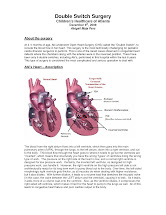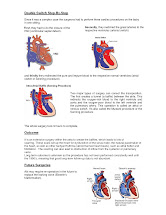We would like to write couple posts on the heart defects Abi was born with, to break down the complexity of her heart and explain one by one.
Normal Heart:
Let's start with the most common heart defect among newborns, Ventricular Septal Defect, or VSD.
To simplify, heart is built of 4 chambers. The two upper chambers are called the atria (left and right atrium) and the two lower chambers are called ventricles (left and right ventricle).
What is VSD?
It is a hole between the two, lower heart chambers.
Interventricular Septum is the wall of tissue between left and right ventricle (the lower chambers), and when there is a single hole or there are multiple holes in this wall, then we talk about VSD.
There are 2 common forms of VSD:
- Muscular VSD
- Membranous VSD or peri-membranous defect
Muscular VSD means there are holes in the muscle wall all over the septum. As long as the holes are small, there is a good chance they will close on their own, or with help of medications over time, without the need for surgery.
If the holes are large or located in the RV outflow tract then the surgery may be required to prevent the VSD from affecting the nearby aortic valve.
Membranous VSD (peri-membranous defect) occurs close to the aortic and tricuspid valves and the hole does not contain muscle tissue.
In any case, when VSD is present, oxygenated blood from the left ventricle, where there's higher pressure, crosses to the right ventricle. The larger the hole the more blood crosses over.
How is VSD discovered?
Usually within the first couple days or weeks of life, a very soft heart murmur maybe heard. Since for the first couple weeks after birth pressures in lungs and right ventricle are higher, less blood crosses from the left ventricle through VSD, hence the murmur can be very soft or even completely absent.
Once the pressures in lungs and right ventricle get lower to normal, more blood will be crossing between the chambers causing more audible murmur.
For some time the baby may be asymptomatic and if the VSD is small, there's a chance it will close on its own. Usually patients are, or at least should be closely monitored.
If the VSD is large or is not closing on its own, there is a chance the baby will develop a congestive heart failure, also called over-circulation.
Since in Abi's case we already knew about VSD, the murmur was discovered early, but it was not very loud.
The following are signs of congestive heart failure, which Abi was showing as well:
- poor feeding
- poor weight gain
- fast breathing even when the baby is fully relaxed and in deep sleep
- excessive sweating
- congestion
- cough
Depending on the size of VSD the aforementioned symptoms may be more or less severe.
Treatment of VSD
If the VSD is small and there are no symptoms of Congestive Heart Failure, there may be no medical nor surgical treatment necessary and the VSD may close by itself.
If the VSD is larger, medication to strengthen heart and diuretics to help body get rid of water, may be applied. If the medication is helping with controlling over-circulation, there's still a chance VSD will close on its own and no surgical intervention will be needed.
Also increasing calories intake, by adding high calorie formula to breast milk, or using less water with formula may be advised to help the baby gain weight.
Surgery
Surgical intervention to close VSD may be necessary when there are no signs of improvement, no signs of VSD closing on its own.
It may also be recommended when the baby is not gaining weight and the Congestive Heart Failure persist, or there is a risk of a permanent damage to other organs due to VSD.
Recovery
Recovering after surgical VSD closure takes couple weeks, but it's been said the complete recovery process is 6 weeks. After closing VSD (if it was the only heart defect) the baby is considered healthy and should not have any further problems as a result of VSD
Art
- Posted using BlogPress from my iPad
Abigail

Thursday, November 1, 2012
Subscribe to:
Comments (Atom)
About Abi's Blog
HELLO!!
This blog is created not only to keep our family and friends updated on Abi's condition, events, surgeries and everyday life... but also to provide legit and educated information about Congenital Heart Defects that touch 1 in 100 babies.
Welcome to Abi's blog with hopes you will find it useful, interesting, touching and even entertaining...
Here are some facts about our sweet baby girl:
Abi was born on July 24th, 2009 with several heart defects that were detected prenatally at 18 weeks: Congenitally Corrected Transposition of the Great Arteries (Congenitally Corrected Transposition of the Great Vessels) (CCTGA = LTGA = L-TGA), Ebstein's Malformation (Ebstein's Anomaly) (malformed tricuspid valve), Pulmonary Stenosis and VSD.
Her first surgery - PA band - was scheduled for December 8th, 2009, however unexpectedly was changed to an Open Heart Surgery (OHS) called Double Switch performed on December 9th, 2009, originally planned for much later...
This blog is created not only to keep our family and friends updated on Abi's condition, events, surgeries and everyday life... but also to provide legit and educated information about Congenital Heart Defects that touch 1 in 100 babies.
Welcome to Abi's blog with hopes you will find it useful, interesting, touching and even entertaining...
Here are some facts about our sweet baby girl:
Abi was born on July 24th, 2009 with several heart defects that were detected prenatally at 18 weeks: Congenitally Corrected Transposition of the Great Arteries (Congenitally Corrected Transposition of the Great Vessels) (CCTGA = LTGA = L-TGA), Ebstein's Malformation (Ebstein's Anomaly) (malformed tricuspid valve), Pulmonary Stenosis and VSD.
Her first surgery - PA band - was scheduled for December 8th, 2009, however unexpectedly was changed to an Open Heart Surgery (OHS) called Double Switch performed on December 9th, 2009, originally planned for much later...
Second OHS was scheduled for March 3rd, 2010 to correct the baffle created during the 1st surgery.
Thank you for your support and prayers.
Art & Joanna (Asia) & Abi.
Thank you for your support and prayers.
Art & Joanna (Asia) & Abi.
You can CONTACT US at: blog@Care4Abi. com
“You never know how strong you are until being strong is the only choice you have!"
Thank you for your generous heart to help cover for Abi's medical expenses...
Early and Intermediate Outcome After Anatomic Repair of CCTGA
Archives
Videos
Popular Posts
-
It's time for the big one. Congenitally Corrected Transposition of the Great Arteries (ccTGA, LTGA). In normal, healthy heart there are...
-
Alright, time for another post. For today I picked another of Abigail's heart's complexities, namely Pulmonary Stenosis (PS). There ...
-
We found out today about the upcoming surgery in Atlanta.. It's scheduled on December 8th. We're leaving on Sunday, December 6th, ...
-
Transposition of the Great Arteries (TGA) In Transpotition of the Great Arteries both, Aorta and Pulmonary Artery are transposed (inverted) ...
CHD Abbreviations:
ASD - Atrial Septal Defect;
DILV - Double Inlet Left Ventricle;
HLHS - Hypoplastic Left Heart Syndrome;
HRV - Hypoplastic Right Ventricle;
LTGA - Levo-Transposition of Great Arteries;
PA - Pulmonary Atresia;
PDA - Patent Ductus Arteriosus;
PS - Pulmonary Stenosis;
TOF - Tetralogy of Fallot
VSD - Ventricular Septal Defect
DILV - Double Inlet Left Ventricle;
HLHS - Hypoplastic Left Heart Syndrome;
HRV - Hypoplastic Right Ventricle;
LTGA - Levo-Transposition of Great Arteries;
PA - Pulmonary Atresia;
PDA - Patent Ductus Arteriosus;
PS - Pulmonary Stenosis;
TOF - Tetralogy of Fallot
VSD - Ventricular Septal Defect










